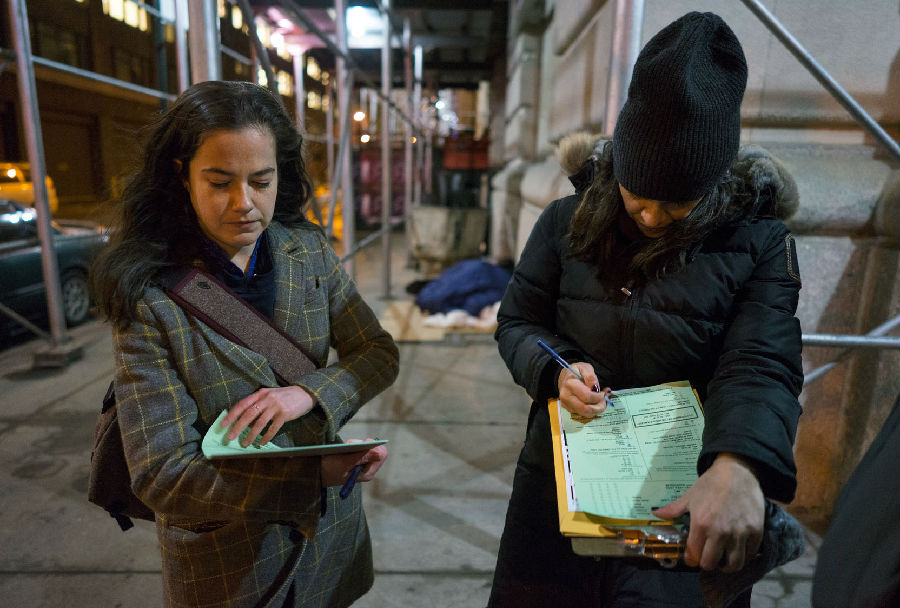The $5 million, 50-employee pilot effort kicked off in August, seeking to assess more than 2,000 people in 90 days.
这项试点工作从8月开始进行,投入资金500万美元,共有50名员工参与运行,该工作旨在用90天的时间对2000多人进行评估。
Chris Block, the director of coordinated entry for Episcopal Community Services of San Francisco (ECS), a charity spearheading the count,
克里斯·布拉克是旧金山市圣公会社区服务(一个带头试行该系统的慈善组织)协调准入项目的负责人,
says his team has spoken to double the number of homeless people he'd anticipated, which has "given us a pretty good baseline of who's the most vulnerable in order to determine housing."
他说他的团队调查过的无家可归者数目比他预期的多一倍,“这给了我们一个很好的基准,让我们知道谁是最需要帮助的人,以此确定住房安排。”
But ONE System faces immense obstacles just getting people to sign up. City employees must gain subjects' trust, learn their real name, and persuade them to join a monitoring system.
但ONE System在让流浪者注册参与项目时面临着巨大的阻碍,员工必须获得受访者的信任,知道他们的真实姓名,说服他们加入监控系统。
Participants must sign the program's medical-records privacy protection forms—a tough task for those suffering from mental illness.
参加者必须签署该计划的医疗记录隐私保护表,这对患有精神疾病的人来说是一项艰巨的任务。
To get permanent housing, program members must pass a background check, which can take 45 days and requires an ID card, something that many people living on the street lack.
为了获得永久性住房,项目成员必须通过背景调查,这可能需要45天的时间,还需要持有身份证,而许多流浪街头的人并没有身份证。
People become homeless for a number of reasons that sometimes overlap—mental illness, unemployment, drug addiction—meaning no amount of data crunching can churn out one easy fix.
人们变得无家可归的原因有很多,有时几种原因同时存在,比如患有精神疾病、失业、吸毒等,这意味着即使进行再多的数据处理也无法获得一个简单的解决方案。
ONE System will also have to combat skepticism about its fundamental creepiness:
ONE System还必须克服人们对该系统抱有的恐惧心态:
If authorities discover drug use or violent crime through the tracking system, for example, could it become a digital policing tool?
如果当权者通过跟踪系统发现吸毒或暴力犯罪等事件,ONE System会不会成为维护治安的数字化工具?

Block and other authorities say no, but there's no law governing use of the data, so it isn't clear what might happen in such situations.
布拉克和其他权威机构负责人表示不会,但目前没有管控数据使用的法律,所以还不清楚在这种情况下会发生什么。
Police haven't monitored the system yet, he says, and "no one is trying to purchase that data, either."
布拉克说,警方还没有监控该系统,“也没有人试图购买这些数据。”
Participants can be removed from the system on request, but Block admits the procedure isn't easy.
参与者可以根据要求从系统中将自己的信息移除,但是布拉克承认移除步骤比较繁琐。
"There's a lot of privacy concerns," he says. "So far those issues haven't been significant, but that doesn't mean they won't come up in the future."
他说:“有很多隐私问题,到目前为止,这些问题还并不显著,但这并不意味着它们将来不会出现。”
Almost half the city's homeless are already part of the system, which will be fully rolled out in the next few months.
旧金山市几乎一半的流浪者信息已经存入系统中,该系统将在未来几个月全面推行。
As of late January, 20 people had been placed in permanent housing, Block says, and 50 more had been helped off the street through counseling or renewed contact with friends and family.
布洛克说,截至1月底,他们已经把20人安置到永久性住房中,还有50人通过咨询或与其朋友和家人重新取得联系而告别露宿街头的生活。
Those relatively modest gains underscore the complexity of the task. Still, Block, a former affordable housing developer, says the goal is to halve the city's homeless population by 2022.
他们取得的些许成果突显出实施该任务的复杂性,然而,前经济适用房开发商布拉克表示,他们的目标是到2022年,将旧金山市的无家可归人口减半。
He expects placements to rise to as many as 90 in the next 90 days. "We'll see a difference on the streets of San Francisco in the next year," he says.
他预计在接下来的90天内,安置人数将上升至90人。他说:“明年,我们将在旧金山街头看到完全不同的景象。”













